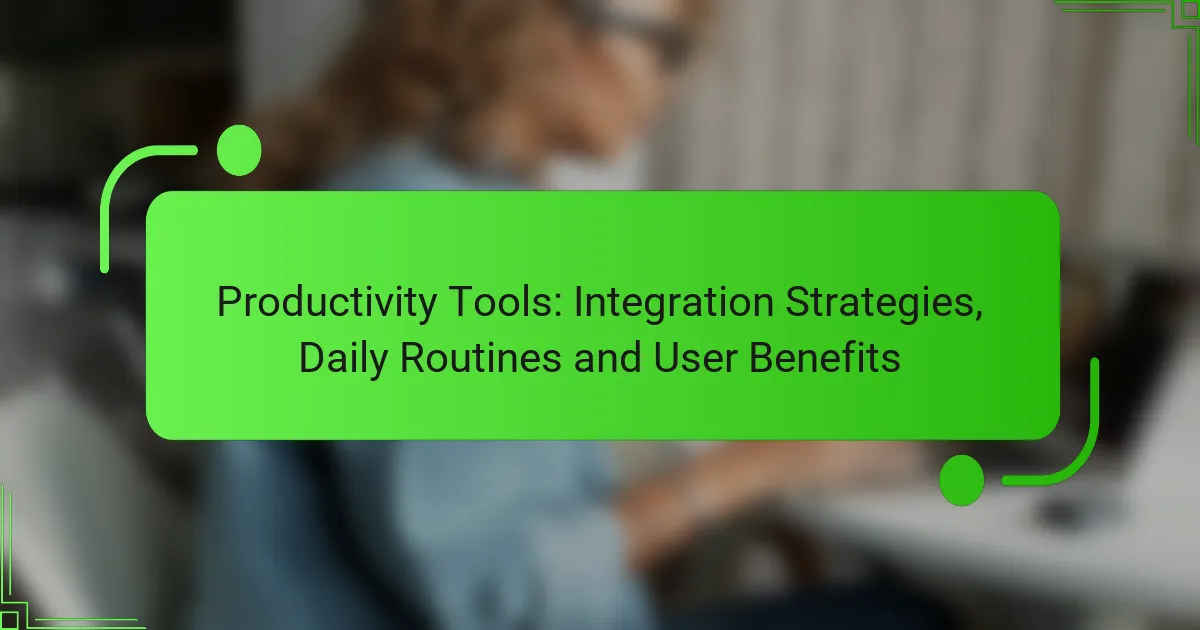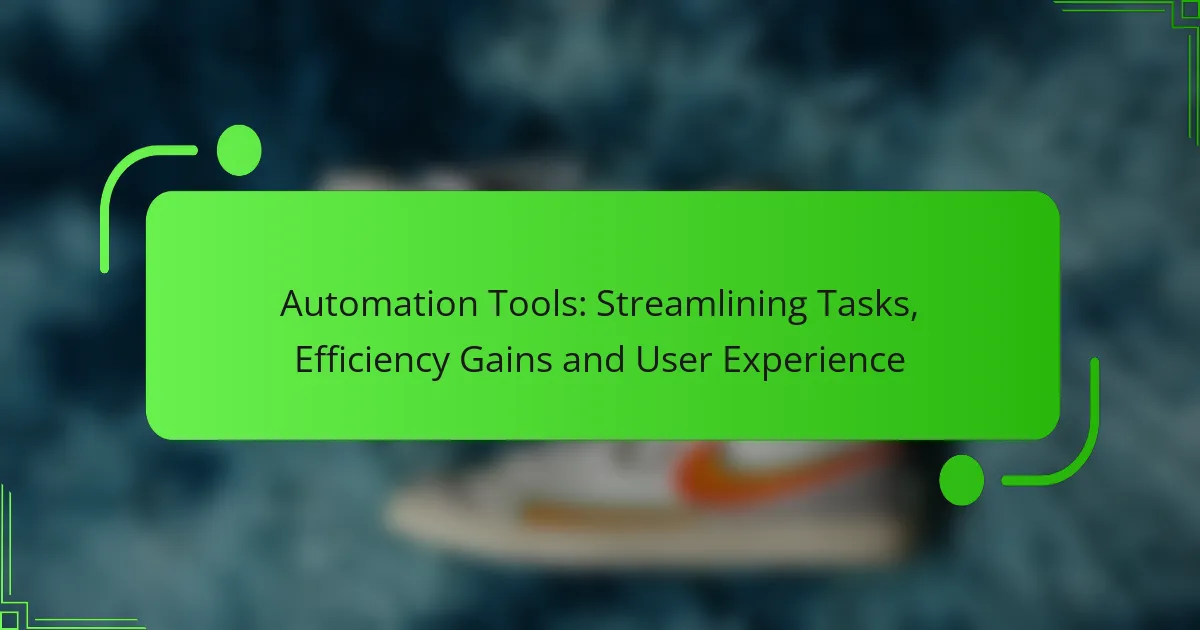In today’s fast-paced environment, leveraging productivity tools is essential for enhancing workflow efficiency and streamlining daily routines. By integrating applications like Trello, Zapier, Slack, and Notion, users can automate tasks and improve collaboration, allowing them to focus on high-priority activities. Ultimately, these tools provide significant benefits, including better time management and increased overall productivity.

What are the best productivity tools for integration?
The best productivity tools for integration enhance workflow efficiency by connecting various applications and streamlining processes. Popular tools include Trello, Zapier, Slack, and Notion, each serving distinct purposes while enabling seamless collaboration and task management.
Trello for project management
Trello is a visual project management tool that uses boards, lists, and cards to organize tasks. It allows teams to track progress, assign responsibilities, and set deadlines, making it easy to visualize project timelines. Users can integrate Trello with other tools like Google Drive and Slack for enhanced functionality.
To maximize Trello’s effectiveness, create clear labels and checklists within cards to specify task requirements. Regularly update boards to reflect current statuses and encourage team members to comment on cards for real-time feedback.
Zapier for automation
Zapier automates repetitive tasks by connecting different apps through workflows called “Zaps.” Users can set triggers in one app that automatically initiate actions in another, saving time on manual data entry and task management. For instance, you can create a Zap that saves email attachments from Gmail directly to Dropbox.
When using Zapier, start with simple automations and gradually build complexity as you become more comfortable. Be mindful of the limits on the number of Zaps and tasks per month based on your subscription plan, which can range from free to premium options.
Slack for team communication
Slack is a messaging platform designed for team communication, offering channels for organized discussions and direct messaging for quick conversations. Its integration capabilities allow users to connect tools like Trello and Google Calendar, centralizing notifications and updates in one place.
To enhance communication in Slack, create dedicated channels for specific projects or topics and encourage team members to use threads for focused discussions. Regularly review channel activity to keep conversations relevant and avoid information overload.
Notion for documentation
Notion is an all-in-one workspace that combines notes, databases, and task management. It allows teams to document processes, share knowledge, and manage projects collaboratively. Notion’s integration with tools like Google Drive and Figma enhances its utility for documentation and design workflows.
To effectively use Notion, establish a clear structure for your workspace with templates for recurring documentation needs. Encourage team members to contribute to shared pages and keep information up-to-date to maintain a reliable knowledge base.

How can productivity tools enhance daily routines?
Productivity tools can significantly streamline daily routines by automating tasks, improving time management, and enhancing collaboration. By integrating these tools into everyday workflows, users can achieve greater efficiency and focus on high-priority activities.
Time blocking with Google Calendar
Time blocking with Google Calendar involves scheduling specific blocks of time for different tasks throughout the day. This method helps users allocate dedicated periods for focused work, meetings, and breaks, reducing distractions and enhancing productivity.
To implement time blocking effectively, start by identifying your most important tasks and estimating how much time each will require. Color-code your calendar to visually distinguish between different types of activities, making it easier to see your commitments at a glance.
A common pitfall is over-scheduling; leave buffer time between blocks to accommodate unexpected interruptions or tasks that take longer than anticipated.
Task prioritization using Todoist
Todoist allows users to prioritize tasks by assigning different levels of importance and deadlines. This helps in focusing on what truly matters and ensures that critical tasks are completed on time.
To prioritize effectively, categorize tasks using labels or projects, and set due dates to create urgency. Use the “Karma” feature to track your productivity trends over time, which can motivate you to stay on track.
Be cautious not to overload your task list; aim for a manageable number of tasks each day to maintain focus and avoid feeling overwhelmed.
Daily stand-ups via Microsoft Teams
Daily stand-ups in Microsoft Teams facilitate quick, focused meetings where team members share updates on their progress and challenges. This practice fosters accountability and keeps everyone aligned on goals.
To conduct effective stand-ups, limit meetings to 15 minutes and ensure each participant answers three key questions: What did I accomplish yesterday? What will I work on today? Are there any blockers? This structure keeps discussions concise and productive.
Avoid lengthy discussions during stand-ups; if a topic requires more time, schedule a follow-up meeting to dive deeper without derailing the daily check-in.

What are the user benefits of productivity tools?
Productivity tools offer users significant advantages, including enhanced efficiency, better collaboration, and improved time management. These benefits help individuals and teams streamline their workflows and achieve their goals more effectively.
Increased efficiency
Using productivity tools can lead to increased efficiency by automating repetitive tasks and simplifying complex processes. For instance, project management software can help track progress and deadlines, reducing the time spent on status updates.
To maximize efficiency, choose tools that integrate well with your existing systems. This minimizes disruptions and allows for a smoother transition, ensuring that your team can quickly adapt to new workflows.
Improved collaboration
Productivity tools enhance collaboration by providing platforms for real-time communication and file sharing. Tools like Slack or Microsoft Teams enable team members to discuss projects instantly, regardless of their physical location.
When selecting collaboration tools, consider features such as document editing capabilities and task assignments. These functionalities help ensure that all team members are aligned and can contribute effectively to shared objectives.
Better time management
Effective productivity tools can significantly improve time management by allowing users to prioritize tasks and set reminders. Applications like Trello or Asana help individuals break down projects into manageable steps, making it easier to focus on what matters most.
To enhance time management, regularly review and adjust your task lists. This practice helps you stay on track and adapt to changing priorities, ensuring that you allocate your time effectively throughout the day.

What integration strategies maximize productivity tools?
Effective integration strategies enhance productivity tools by streamlining workflows and reducing manual tasks. Leveraging APIs and automation platforms can significantly improve efficiency and collaboration across various applications.
API connections for seamless workflows
API connections allow different software applications to communicate and share data, creating seamless workflows. By integrating tools like project management software with communication platforms, teams can automate updates and notifications, reducing the need for manual input.
When considering API integrations, evaluate the compatibility of your tools and the complexity of the integration process. Many platforms offer pre-built connectors, which can simplify setup and reduce the time spent on configuration.
For example, connecting a customer relationship management (CRM) system with email marketing tools can automate lead nurturing processes, ensuring timely follow-ups without additional effort from your team.
Using IFTTT for cross-platform automation
IFTTT (If This Then That) is a powerful tool for automating tasks across different platforms. It allows users to create simple conditional statements that trigger actions based on specific events, enhancing productivity by minimizing repetitive tasks.
To use IFTTT effectively, identify key tasks that can be automated, such as posting social media updates when a new blog is published or saving email attachments directly to cloud storage. This can save time and ensure consistency across platforms.
Be mindful of the limits of IFTTT, such as the number of applets you can create on a free plan. For extensive automation needs, consider upgrading to a paid plan or exploring alternative automation tools that may offer more features.

What criteria should be considered when selecting productivity tools?
When selecting productivity tools, consider user interface and experience, integration capabilities, and cost and scalability. These factors significantly impact how effectively a tool can enhance your workflow and overall productivity.
User interface and experience
The user interface (UI) and overall experience are crucial for productivity tools as they determine how easily users can navigate and utilize the software. A clean, intuitive design minimizes the learning curve and allows users to focus on tasks rather than figuring out how to use the tool.
Look for tools that offer customizable dashboards and easy access to frequently used features. User feedback and reviews can provide insights into the usability of a tool, helping you avoid options that may frustrate users.
Integration capabilities
Integration capabilities refer to how well a productivity tool connects with other software and services you already use. Tools that can seamlessly integrate with email, project management software, and calendars can streamline workflows and reduce the need for manual data entry.
Evaluate whether the tool supports popular APIs or has built-in integrations with essential applications. A tool that can connect with at least five to ten commonly used platforms is often more versatile and beneficial for users.
Cost and scalability
Cost is a significant factor when selecting productivity tools, especially for businesses. Consider both the upfront costs and any ongoing subscription fees. Many tools offer tiered pricing based on features or user counts, allowing you to choose a plan that fits your budget.
Scalability is equally important; choose tools that can grow with your needs. Look for options that allow you to add users or features without a complete overhaul, ensuring that your investment remains valuable as your team or project expands.


